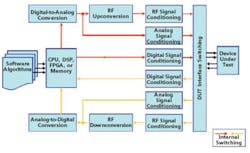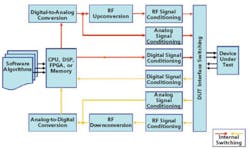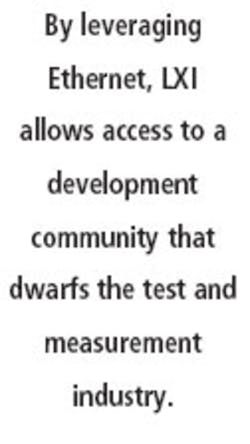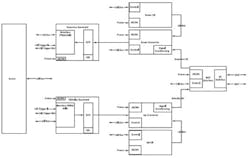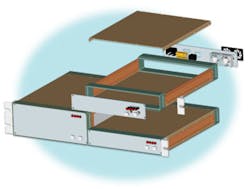Synthetic instruments may have found the common interface they require in LXI.
Synthetic instruments (SIs), built from modular components and enabled by high-speed processors and modern bus technologies, promise test users increased functionality and flexibility, lower total cost of ownership, higher speed operation, smaller physical footprint, and longer supportable life. One problem that both manufacturers and customers face is the lack of a common design standard that meets their architectural and commercial needs.
PXI and VXI modular instrumentation are candidates for this application. But they force many constraints on the designers of SI, resulting in hybrid systems with proprietary interfaces and custom module packaging.
SI Top-Level Requirements and Architecture
At first glance, the general requirements for SI are similar to those of conventional rack-and-stack instruments. On further investigation, we discover hidden requirements unique to synthetic architectures, so it is worth starting with a quick look at general SI systems.
There have been many definitions of SIs over the years, leading to some confusion and misunderstanding. At the most fundamental level, SIs simply are collections of generic hardware and software modules that may be combined to perform a variety of traditional test functions.
Recently, the SI Working Group, sponsored by the Department of Defense, provided stability to the discussion by publishing the architectural description shown in Figure 1. The SI Working Group was chartered to define SI component/module specifications for military applications and promises to have a significant effect on the course of SI development in the coming years.
SI architectures provide the capability to assemble instruments from standard modules individually selected to supply the required test capabilities and specifications. Figure 1 shows the main components of a typical SI stimulus/response system but fails to help us understand the actual characteristics of the modules themselves.
System integrators using SI architectures must select modules capable of supporting the desired system specification and assemble them into an architecture with adequate data and trigger-bus performance. This modular architecture provides many benefits in terms of cost/performance trade-offs. For example, you would not select an expensive, extremely fast-switching local oscillator if the final system only makes single frequency measurements.
With SI, in an ideal world, systems integrators could select from a range of components with common interfaces but feature different capabilities and price points when building test systems. The challenge that the SI manufacturers now face is the definition and acceptance of a common standard that would allow this module assembly to actually happen without the use of a hacksaw.
SI Modules and Components
So can we define general module characteristics and derive interoperability requirements? It probably is better to start with the physical requirements since these define how modules fit together in a typical system rack.
Some attributes are fairly clear: We would like a package that provides good RF isolation, size flexibility, adequate cooling, and easy IO access. We would like the overall size to be flexible to accommodate large, high-power microwave components, and we would like power supplies to scale with module needs, such as baseband switch modules that consume far less power than RF.
We would like to build from the lessons card-cage modular formats taught us about the limits of tightly constrained physical enclosures that do not accommodate large RF modules and avoid isolation problems between computer bus standards and sensitive RF signals. An additional concern is that the over-constrained physical requirements associated with card-cage formats conspire to limit module availability and can drive up prices by preventing manufacturers from leveraging investments in rack instruments into SI modules.
Electrical requirements, particularly data and control bus bandwidth and latencies, often drive module design decisions. Baseband modules can drive significant data between modules, particularly with systems that generate and acquire complex modulation patterns where data rates of 20 to 50 MB/s are not uncommon for modern military digital communications protocols.
The data and control requirements between up and down converters, local oscillators, signal conditioning, and DUT interfaces are modest. Switch synchronization requirements vary between the microsecond level for pin diodes out to tens of milliseconds for mechanical switches and attenuators. Synchronization between stimulus and response and baseband modules, historically in the tens of nanoseconds for demanding applications, is more challenging.
This gives us a picture of a composite system where the baseband modules are connected by a high-speed data bus with bandwidths exceeding 50 MB/s within a larger system with data bus bandwidths in the order of 10 MB/s. Although these requirements can vary for specific applications, we believe they are fairly typical for the majority of SI applications and give us a starting point for the discussion about the applicability of the LXI standard.
LXI Overview and History
In 1972, the Hewlett-Packard Interface Bus (HP-IB) was introduced as an open standard communications bus (IEEE 488) for instrument-to-computer communications. Later renamed general-purpose interface bus (GPIB), it was found on nearly every instrument over the past 30 years and defined test-system architectures. The popularity of GPIB was driven by longevity and stability; it was a single interface standard test-system designers could count on.
In 1985, Hewlett-Packard (now Agilent Technologies), Tektronix, Wavetek, Racal-Dana, and Colorado Data Systems introduced VME eXtensions for Instruments (VXI), a modular instrument standard for the U.S. military. These modular instruments became very popular in the aerospace/defense industry and manufacturing test applications where size and throughput were important.
But time moves on, and new technologies become available. Unlike the early days of GPIB when simple computer-to-instrument communications were the goal and few alternatives existed, low-cost serial communications buses have emerged with extremely high performance. These modern switched-fabric technologies such as Infiniband, Rocket I/O, PCIExpress, and Gigabit Ethernet changed the face of computer communications architectures.
Conventional parallel buses became expensive bottlenecks for communications between nodes on a network. In this changing environment, test and measurement manufacturers saw the advantages of using low-cost, high-speed serial buses for instrument communications, releasing them from parallel-bus architectural constraints.
Ethernet is an attractive solution. It is a stable, single ubiquitous high-speed connectivity standard with extensive network management capabilities and media independence.
Over the past two decades, Ethernet evolved far faster than test and measurement-derived interfaces, yet it preserves excellent backward compatibility and stability. In the latest Gigabit incarnation, Ethernet finally has achieved the performance required to become the fabric of the interface architecture required by the SI community.
In 2004, Agilent Technologies and VXI Technology founded the LAN-based eXtensions for Instrumentation (LXI) Consortium, a not-for-profit corporation to develop and promote an open industry standard that ensures interoperability between local area network (LAN)-based instruments.1 With many companies independently considering Ethernet-based instruments and SI modules for the functional test, measurement, and data acquisition industries, defining consistent implementation practices made sense. The founders reasoned that independent implementation would result in poor interoperability and doom Ethernet as a viable successor to GPIB.
LXI Functionality and Performance
LXI primarily is a functional interface specification that defines implementation practices for Ethernet 802.3-based interface technology to ensure interoperability between instruments with an embedded IEEE 1588 protocol to provide the required synchronization capabilities.2 In addition, it specifies an associated wired trigger bus to provide enhanced synchronization capabilities for critical applications.
There are three LXI conformance classes, differing primarily in mechanical dimensions and triggering/synchronization requirements:
� For SIs, LXI Class A is the most interesting, with deterministic timing provided by the IEEE 1588 synchronization protocol and a high-speed wired low-voltage differential signalling trigger bus. Since most SI modules have no front panel or display, the user interface is defined through a web interface, and an interchangeable virtual instruments application programming interface (IVI API) provides communications among computers and modules. LXI mechanical specifications ensure modules behave as good system neighbors.
� The trigger bus operates at 100 MHz, providing 1-ns accuracy with installed achievable performance of approximately 2 ns, and can be configured in star, daisy-chain, or hybrid architectures. The IEEE 1588 protocol uses real-time clocks to provide deterministic network timing independent of underlying LAN speed.
� The IEEE 1588 protocol provides timing synchronization to around 50 ns at a 2-sigma distribution over the LXI Ethernet bus. The data throughput and latency of the LXI bus obviously depend to a large degree on the processors and interface hardware. As for Gigabit Ethernet performance, it is worth quoting from one of the many sources on this topic:
�Gigabit Ethernet has now become commonplace in servers and workstations. While its signaling rate of 1 Gb/s translates to a peak bandwidth of about 120 MB/s, this performance level is rarely achieved in practice. The standard connection-oriented protocol carried on Ethernet is TCP/IP. Because the host CPU is generally responsible for implementing the computer intensive TCP/IP software stack, one typically observes a relatively large latency, in the range of 50 to 120 �s, for zero-byte messages.�3
The magnitude of these latencies should be kept in the context of typical SI design requirements. Most advanced SI architectures have moved to the use of common test schedules or state machine schedules distributed to the various active modules in the system, with the schedule synchronization being accomplished in the 1588 protocol. This allows widely distributed components to synchronize events in approximately 100 ns. More accurate synchronization of the schedule events can be accomplished by the wired trigger bus.
The only time that the LXI bus latencies become significant is in the execution of procedural events in a script-like environment. In this case, typical programming techniques will require the host CPU to switch context to execute the command, and there also may be other latencies involved in script interpretation.
The context switching time for both Microsoft XP and Linux was investigated by Dr. Bradford in Reference 4 and reported as commonly exceeding 30 �s. With any additional interpreter latency, this and not the Ethernet bus latency is the dominant factor in end-to-end data and event transport between modules.
SI Designs Using the LXI Standard
SI systems can easily be built with parts of the baseband architecture embedded in a VXI or PXI cage. However, it is difficult to fully contain the RF architecture within this same mechanical and electrical environment, especially for high-performance microwave systems. This has led many manufacturers to design hybrid systems using a combination of card-cage-based baseband connected to larger RF components.
With these solutions available, why does LXI provide an attractive new standard for these applications? The answer has to do with the trade-offs and constraints imposed by card-cage solutions and the resultant hybrid architectures used to avoid these limitations.
Baseband and low-frequency modules lend themselves to VXI and PXI, but it has proven very difficult to build RF and microwave systems within the mechanical and electrical environment presented by these standards. RF and microwave components typically do not fit within card constraints, shielding is very challenging, and power-hungry RF devices often tax power supplies.
The result is a lack of high-performance RF and microwave products in these formats, forcing system integrators to develop hybrid systems with baseband modules in a commercial cage combined with custom RF modules controlled by proprietary data and control buses. It is not in the interest of either the manufacturer or consumer to deal with independent implementations since they will negate many of the module interchange and system configurability benefits that otherwise would be inherent in these SI designs.
A standards-based system using Ethernet as the main system bus offers many attractive advantages. Advanced network features such as peer-to-peer communications are not available in traditional test and measurement interfaces, and Ethernet cables and cards are standard, widely available, and essentially free.
Power-over-Ethernet (PoE) and the IEEE 1588 protocol simplify distributed measurement applications where large numbers of sensors are distributed around a large DUT or distributed geographically, and IEEE 1588 time stamping simplifies data and channel management and post-acquisition analysis. A possible architecture for a typical stimulus/response SI test system is shown in Figure 2.
click here to see larger image
The architecture has separate stimulus and response baseband modules connected to a server via the LXI bus and an LXI trigger bus between baseband modules. In this design, the frequency converters provide signal conditioning.
But in practice, the task could be separated as shown in Figure 1. The DUT interface provides interface switching and loop-back calibration functions but also could include signal conditioning, high-power stimulus amplification, and low noise response amplification.
This example, built around the LXI standard, easily meets the needs and exceeds the performance of most SI systems built today. Bus bandwidths are 50 MB/s, baseband trigger accuracies are about 2 ns over the LXI trigger bus, and up/down converter and DUT trigger accuracies over IEEE 1588 are well below 100 ns. Further, IEEE 1588 allows time stamping for post-acquisition analysis that previously was not available with event-driven triggering.
LXI Packing Density, Cooling, and Power
Since LXI is primarily an interface standard, it presents few mechanical constraints on test instruments. For SIs and applications where size is a priority, the LXI mechanical specification defines a 1U half-rack width module that can be tightly integrated in a stack of similar modules with cooling and cabling interfaces designed for this type of application.
The rear panel has the LXI and trigger-bus connectors, and either AC or DC power is allowed. The front panel contains the status lights and reset buttons, and the units can be mounted in a 19-in. rack through the use of the intermodule and rack-mounting ears.
Although manufacturers will want to qualify their own units for thermal stability, initial studies by the consortium have shown that each 1U unit can reasonably handle around 100 W without any particular design concerns, and 2U units are good for around 400 W on a similar basis. Figure 3 illustrates this configuration for high-density applications, with a combination of 1U and 2U modules in a high-density stack suitable for a 19-in. rack-mount enclosure.
Conclusions and the Road Ahead
In SI system scenarios, LXI is an attractive alternative built upon open Ethernet standards and free from the size constraints imposed by existing bus-specific standards. It offers a component-based architecture capable of meeting both the low-cost and the high-performance needs of test-system integrators with a digital bus interface tied to modern telecommunications hardware development.
By leveraging Ethernet, LXI allows access to state-of-the-art high-performance processors and servers. But most of all, the emergence of a true physical and functional component-based architecture, capable of meeting both the low-cost and the high-performance ends of the SI spectrum, can provide benefits in the establishment of a truly interchangeable commercial SI standard.
References
1. LXI Consortium, http://www.lxistandard.org/home
2. IEEE 1588 Standard, http://ieee1588.nist.gov/
3. Jonsson, Dr. L.E., and Magro, Dr. W.R., �Comparative Performance of InfiniBand Architecture and Gigabit Ethernet Interconnects on Intel� Itanium� 2 Microarchitecture-Based Clusters,� Intel Americas.
4. Bradford, Dr. E.G., �High-Performance Programming Techniques on Linux and Windows,� IBM, July 2002.
About the Authors
David Poole works for the System Division of Aeroflex as a technical fellow and is the chairman of the LXI Physical Specifications Working Group. He has degrees in math and physics, is a graduate of the USN Test Pilot School, and has a background in math models, digital control, instrumentation, and test systems. Aeroflex Systems Division, 4201 Northview Dr., Bowie, MD 21706, 410-693-2561, e-mail: [email protected]
Bob Rennard is a program manager at Agilent Technologies and president of the LXI Consortium. He received degrees in engineering and an M.B.A. from Northwestern University and has held a number of positions in the test and measurement business, including marketing manager for spectrum analyzers and signal generators. Agilent Technologies, 1400 Fountaingrove Parkway, Santa Rosa, CA 95403, 707-577-3140, e-mail: bob_rennard@ agilent.com
April 2005
